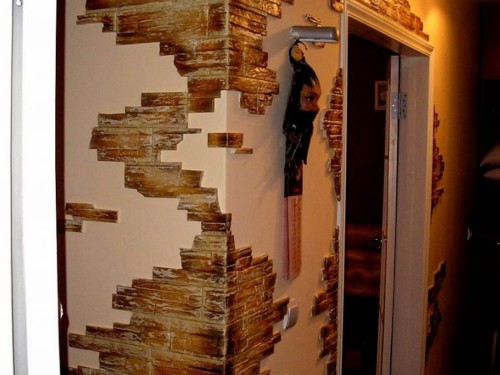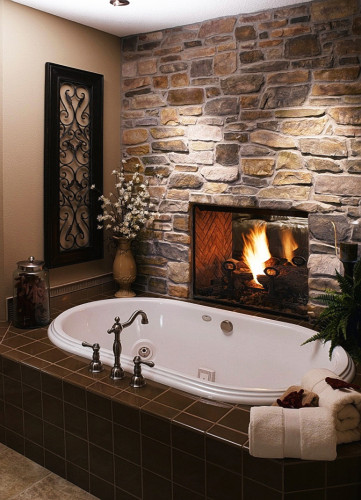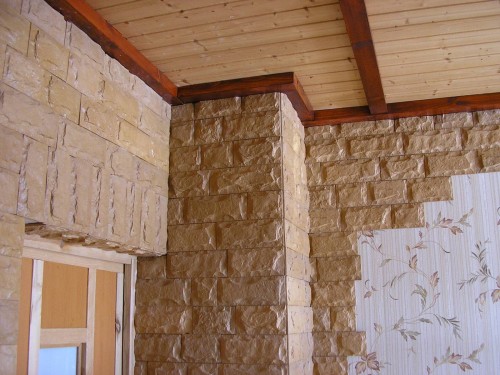The stone is an integral component when creating an original interior. Obviously, this natural material has always been highly valued, and recently its cost has also increased significantly. The thing is that this finishing resource is incredibly in demand, and it is often used in large projects, where there is a need to use a large amount of stone.
Content
But do not forget about artificial stone. Many mistakenly believe that it is better not to resort to this option, however, practice shows that for most parameters, artificial material does not differ from the real stone. Moreover, the decorative material may be simply an amazing appearance, shape and, of course, texture.
Interestingly, recently by the release of decorative material is engaged in small production. This, of course, is about handicraft production. It is quite realistic to release a decorative stone with your own hands. There is nothing difficult here. Moreover, it is a fairly low-cost process, so there are no restrictions in this direction. It all depends on existing resources, opportunities and, possibly, fantasies.
Now we will look at the main features of the decorative material, as well as try to analyze the main stages of the production of this product with their own hands.
Main features of decorative stone
Immediately it is worth saying that the decorative stone differs from natural, above all, appearance. Obviously, the most often artificial material is produced in the form of bricks, a small tile. At the same time, natural stone is available in the form of a regular block, which also looks good in the overall dwelling interior. Accordingly, for many people, a decorative stone is preferable, as it has fixed dimensions, a strict appearance, as well as direct fitness for the construction process.
Accordingly, each owner, having familiarized himself with the size of a decorative stone, can make a wall decoration plan. It is incredibly convenient and really practical. The network has a huge number of finishing options, and it is at similar options that can be founded about the finishing work.
Advantages of artificial stone over natural
As we said, an artificial stone is a more practical option than natural material. And in this case, it should be noted several reasons:
- Price issue. Obviously, artificial material is cheaper than natural. Moreover, in modern conditions, the difference between these two options is simply colossal. Also, you should not forget that for the same money you can buy much more artificial product than natural. Accordingly, you can noticeably increase the decoration area. Well, of course, it is worth saying that now people are trying to save on everything, so such savings are unequivocally pleasing.
- Weight material. Natural stone is much harder to artificial. Accordingly, if we finish the premises, then the decorative material in this regard is much more reliable and more practical. Moreover, in such conditions it is necessary to seriously treat the material, with which the stone will occur. For example, a durable cement is used to install a natural material, but an artificial stone can be fixed without problems with liquid nails and other types of glue. In this case, you can also trace considerable savings, as well as take care of the pleasant appearance of the finish.
- Transportation. Given that natural stone has a lot of weight, it is much more difficult to transport than decorative material. Moreover, this applies not only to the transportation of products with specialized logistics companies. Many owners use their own strength in order to deliver the necessary cargo to their dwelling. Accordingly, in such cases (when delivering a natural stone), it is necessary to either use large transport, or divide the entire volume of material into several parts, if the cargo is much and he is heavy. With an artificial stone, everything is much easier. Most often, such a product has a special packaging, which is incredibly easy to transport over long distances, even if we have a small passenger car.
Decorative stone has disadvantages. For example, it is possible to note the high abrasability of surfaces, but this is only if we use artificial material as an outdoor coating. In addition, under the action of ultraviolet, the image on an artificial stone can be a little fading. Avoid the action of sunlight. In any case, the above points cannot be called significant disadvantages.
Varieties of artificial stone
There is a lot of varieties of artificial stone. In some cases, this material is very difficult to distinguish from natural stone. This is most likely the main advantage of an artificial product.
Often on sale you can find a bold stone. With the help of an ordinary hammer, the manufacturer ensures that the stone looks closest to its initial mind. Small chips only add attractiveness of this product.
Sawn stone. In this case, artificial material is amenable to filling, and ultimately we get smooth smooth edges that are characteristic of high-quality paving slabs. It is also a good option for those who want to bind walls.
Dog stone. These are the most common forms for natural stone, but to achieve such a result for the production of artificial material, special forms are used. Accordingly, in this case, we get the most ordinary boulders.
Decorative material. This is the most common variation of artificial stone. Each unit of such a product has a fixed size and a memorable form. For the decor, this option is also optimal because, based on the presented sizes of the stone, we can make a sketch and a full-fledged finishing plan.
Materials for the manufacture of artificial stone
Of course, there is no single material for the production of artificial stone. Sometimes a cement solution is used for this, and sometimes the excellent option is the gypsum or even alabaster. Also recently, the decorative stone is made on the basis of polymeric materials. Ultimately, the quality of such a product is very high, just as cost.
It is good that almost any person can engage in the production of artificial stone. For this you do not need to have a building education or extensive experience. After the first manufactured products, everything becomes clear at once.
Of course, in handicraft conditions, it is best to produce artificial stone based on cement or gypsum. These are the most optimal and inexpensive options. In case of any problems associated with the process of creating a stone, you can not despair and try again.
Forms for the production of artificial stone
Regardless which material is used to create an artificial stone, there is a need to acquire a form in which our product will be melted. For a full-fledged building process, you must have several forms that allow you to quickly carry out the stone laying. It is advisable to acquire the same forms that coincide in size and the style of execution. However, you can apply more original solutions. For example, some owners use 3 different versions of the forms that perfectly complement each other, create an original facing style.
Most often forms for artificial stone are made on the basis of silicone. This is a practical material that has no deficiencies associated with the production of stone. All these forms are soft enough and rush, so in the process of the production of material you need to keep in mind, as it is very easy to damage the product.
If there is an opportunity or desire to create your own forms for the production of artificial stone, there is also nothing complicated here. You just need to make a small formwork, which will have the box shape. On the bottom of the box we put several stones (about the same size), which will be a model to create a form. Now you need to arm a silicone and fill them with a box (for several centimeters). After some time, silicone material is extracted, and created empties and are a kind of stencil for the release of stone. However, you need to know that in this case a lot depends on the selection of stone (sample). This natural resource should have an attractive shape and absence of sharp edges. The process of making a form often takes up to three weeks, longer have to wait for the moment when silicone dries off. After that, the created formwork is disassembled, and the form becomes suitable for use.
Artificial stone from cement or gypsum
- Based on cement. If it is decided to make an artificial stone-based stone based on cement, the process should be started with sand and cement mixing in a ratio of 1 to 3. These ingredients are mixed to a homogeneous state, after which water is added. After that, the condition of the mixture must correspond to the consistency of sour cream. Next, you can safely fill the shapes with a cooked mixture. It should be borne in mind that the mixture must be slightly concentrated so that there are no voids inside inside, negatively affect the appearance and state of the future product. After about 10-12 hours, the stone can be removed from the form, but it is possible to use it in construction only after a couple of weeks.
- Based on gypsum. In many ways, the production of artificial stone based on gypsum is similar to what we have considered in the last paragraph. However, the attention should be focused on the fact that the process of frozen plaster is far faster. Accordingly, after 30-40 minutes, it is possible to extract the product from the form. Previously need to lubricate the shape for a stone with oil so that the product can be easily removed. It should be noted that the cement stone is more practical than gypsum. The thing is that the stone produced on the basis of cement, among other things, can be used as an outer finish.
Production of artificial stone and dyes
Obviously, without dyes in this case can not do, otherwise it will not be possible to create an original design.
In some cases, painting any stone after production. This is the easiest way, but it is not very practical, since an externally product may not look very presentable. To do this, we only need to clean the stones from dirt and dust, after which a thin layer of paint is applied to the brush to the stone (several layers can be applied).
However, the most common staining of the stone occurs directly during the production of material. As an example, we analyze the features of using the dye when creating a cement-based stone:
- The dye is added to the cement during the mixing of the mixture. Most often, the optimal volume of the dye is 3% of the total volume of the mixture. Of course, it is necessary to produce high-quality mixing of the material so that the mixture is homogeneous.
- Now the forms are filled with a mixture of approximately half. If everything is done correctly, but the cement must have an appropriate color.
- The second half of the form can be filled with conventional cement mortar, as there is simply no need to use too much dyes. On the surface of the solution with the color you need to position the metal grid, which will ensure the high strength of the material.
At the very end, it does not hurt to apply a small texture on the upper layer of the solution, which will allow you to better seize the material when facing the surface.
The most important thing is the time you need to wait before the finishing material can be used in the process of wall decoration. If all the technology corresponds, then the artificial stone will be durable and durable.























